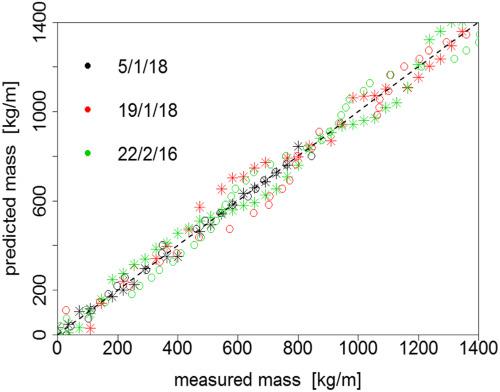当前位置:
X-MOL 学术
›
Earth Surf.Process. Land.
›
论文详情
Our official English website, www.x-mol.net, welcomes your feedback! (Note: you will need to create a separate account there.)
Novel mass‐aggregation‐based calibration of an acoustic method of monitoring bedload flux by infrequent desert flash floods
Earth Surface Processes and Landforms ( IF 3.3 ) Pub Date : 2020-08-27 , DOI: 10.1002/esp.4988 Eran Halfi 1 , Dror Paz 2 , Kyle Stark 3 , Uri Yogev 4 , Ian Reid 5 , Michael Dorman 2 , Jonathan B. Laronne 2
Earth Surface Processes and Landforms ( IF 3.3 ) Pub Date : 2020-08-27 , DOI: 10.1002/esp.4988 Eran Halfi 1 , Dror Paz 2 , Kyle Stark 3 , Uri Yogev 4 , Ian Reid 5 , Michael Dorman 2 , Jonathan B. Laronne 2
Affiliation

|
The monitoring of bedload flux under flash flood conditions has been successfully achieved since 1992 using slot samplers in the semiarid Nahal Eshtemoa. In the present study, a surrogate bedload monitoring technique ‐ the Japanese plate microphone ‐ has been deployed and calibrated against data from the slot samplers. Since a slot sampler has a sensitivity threshold that becomes especially important when transport rates are low, different averaging periods should be considered for high and low fluxes. In order to overcome the deficiencies of time‐based aggregation used hitherto, we have developed a new method involving mass aggregation and commensurably variable intervals, thereby enabling a more accurate analysis and optimizing the bedload sampler's capabilities. The data derived with this new method has then been utilized to calibrate the Japanese plate microphone. The Eshtemoa is an ephemeral gravel bed channel with a high proportion of fine gravel (< 0.02 m); for these conditions, acoustic sensors have not been calibrated as yet. Two multiple linear regression models incorporating the effect of median bedload grain size on pulse rate have been established to predict bedload flux and cumulative transported bedload mass. The coefficients in these models are statistically significant. Good predictions are obtained for bedload flux (adj. r2 = 0.83) and for cumulative bedload mass (adj. r2 = 0.98) during flood recession. Overall, the multiple linear regression models, used in conjunction with the mass aggregation method of estimating bedload flux, suggest that field calibration of acoustic devices is feasible under these conditions for ca. 90% of the duration of bedload transport. © 2020 John Wiley & Sons, Ltd.
中文翻译:

基于新的基于质量聚集的校准方法,该方法通过罕见的沙漠山洪暴发来监测床荷通量
自1992年以来,在半干旱的Nahal Eshtemoa中使用缝隙采样器成功地实现了对洪水泛滥条件下的床荷通量的监控。在本研究中,已经部署了替代床载监控技术-日式平板麦克风-并根据时隙采样器的数据进行了校准。由于缝隙采样器的灵敏度阈值在传输速率低时变得尤为重要,因此对于高通量和低通量应考虑不同的平均周期。为了克服迄今为止使用的基于时间的聚合的不足,我们开发了一种新方法,该方法涉及质量聚合和相称可变的间隔,从而可以进行更准确的分析并优化床载采样器的功能。然后,利用这种新方法得出的数据已用于校准日式平板麦克风。Eshtemoa是一个短暂的砾石床通道,细砾石比例很高(<0.02 m)。对于这些情况,尚未对声学传感器进行校准。已经建立了两个结合了中位床粒粒度对脉搏率影响的多元线性回归模型,以预测床粒通量和累积运输的床粒质量。这些模型中的系数具有统计意义。床载通量获得了很好的预测(调整r 已经建立了两个结合了中位床粒粒度对脉搏率影响的多元线性回归模型,以预测床粒通量和累积运输的床粒质量。这些模型中的系数具有统计意义。床载通量获得了良好的预测(调整r 已经建立了两个结合了中位床粒粒度对脉搏率影响的多元线性回归模型,以预测床粒通量和累积运输的床粒质量。这些模型中的系数具有统计意义。床载通量获得了良好的预测(调整r2 = 0.83)和洪水衰退期间的累积床载质量(调整r 2 = 0.98)。总体而言,与估计床载通量的质量聚集方法结合使用的多个线性回归模型表明,在这些条件下,大约需要声学设备进行现场校准。床载运输时间的90%。分级为4 +©2020 John Wiley&Sons,Ltd.
更新日期:2020-11-03
中文翻译:

基于新的基于质量聚集的校准方法,该方法通过罕见的沙漠山洪暴发来监测床荷通量
自1992年以来,在半干旱的Nahal Eshtemoa中使用缝隙采样器成功地实现了对洪水泛滥条件下的床荷通量的监控。在本研究中,已经部署了替代床载监控技术-日式平板麦克风-并根据时隙采样器的数据进行了校准。由于缝隙采样器的灵敏度阈值在传输速率低时变得尤为重要,因此对于高通量和低通量应考虑不同的平均周期。为了克服迄今为止使用的基于时间的聚合的不足,我们开发了一种新方法,该方法涉及质量聚合和相称可变的间隔,从而可以进行更准确的分析并优化床载采样器的功能。然后,利用这种新方法得出的数据已用于校准日式平板麦克风。Eshtemoa是一个短暂的砾石床通道,细砾石比例很高(<0.02 m)。对于这些情况,尚未对声学传感器进行校准。已经建立了两个结合了中位床粒粒度对脉搏率影响的多元线性回归模型,以预测床粒通量和累积运输的床粒质量。这些模型中的系数具有统计意义。床载通量获得了很好的预测(调整r 已经建立了两个结合了中位床粒粒度对脉搏率影响的多元线性回归模型,以预测床粒通量和累积运输的床粒质量。这些模型中的系数具有统计意义。床载通量获得了良好的预测(调整r 已经建立了两个结合了中位床粒粒度对脉搏率影响的多元线性回归模型,以预测床粒通量和累积运输的床粒质量。这些模型中的系数具有统计意义。床载通量获得了良好的预测(调整r2 = 0.83)和洪水衰退期间的累积床载质量(调整r 2 = 0.98)。总体而言,与估计床载通量的质量聚集方法结合使用的多个线性回归模型表明,在这些条件下,大约需要声学设备进行现场校准。床载运输时间的90%。分级为4 +©2020 John Wiley&Sons,Ltd.



























 京公网安备 11010802027423号
京公网安备 11010802027423号